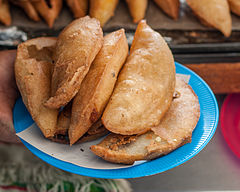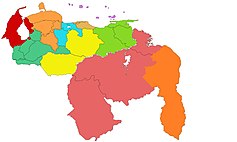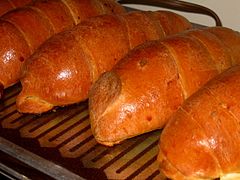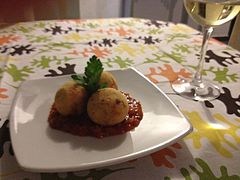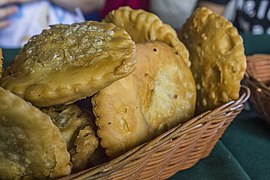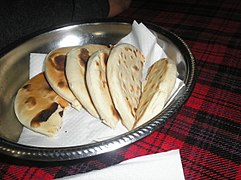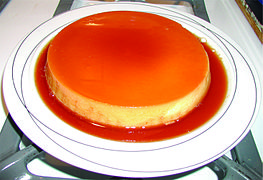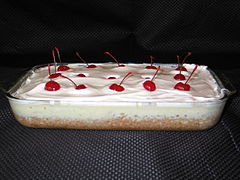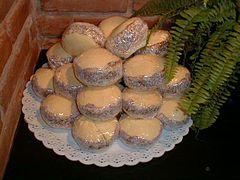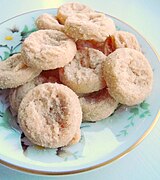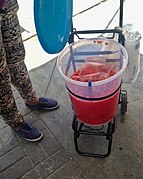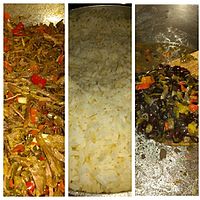Venezuelan gastronomy
The Venezuelan gastronomy is a varied way of preparing food and drinks made in that country, constituting the result of the cultural and gastronomic mix from Europe (especially Spain, Italy, Germany, France, the Netherlands and Portugal) and Africa (through the slave populations brought by the Spanish) with the gastronomy of the indigenous peoples of Venezuela.
Overall, it has received notable influences from Mediterranean gastronomy. The best-known dish is the arepa, a kind of circular-shaped roasted bun made of corn dough that is eaten stuffed with other foods or used as a side dish. Other well-known dishes are the pabellón criollo, the hallaca, the sancocho, the fried empanadas, the grilled meat, the black roast, the mondongo, the cachapa and the grilled chicken. There are basic ingredients that are part of a large number of Venezuelan dishes such as corn, tubers, sugar cane, cassava, chili, grains, plantains, meat and poultry.
Main features
Venezuelan dishes can vary depending on the geographical area of the country. Venezuelan gastronomy is varied, and sometimes it can result from the mixture of cultures that inhabited the country in the past, such as that of the indigenous people and then the arrival of Europeans who from their lands brought with them gastronomic diversity such as Spanish, Italian and Mediterranean. Some of the most common ingredients in preparations are cereals such as rice and corn, lentils, beans, peas, beans and other grains, tubers such as potatoes, yams and sweet potatoes; tuberous roots such as cassava, ocumo and Chinese ocumo, meats such as beef, chicken, chicken, goat meat, pig (pork), chigüire (capybara), venison and a wide variety of fish and shellfish. The variety of tropical fruits such as mango, cambur (guineo/banana), lechoza (papaya/pumpkin), guava and passion fruit (passion fruit/chinola) is also important.
Venezuela has several representative dishes of a national character such as arepas, ham bread, tequeño, the Creole pabellón and the typical hallaca at Christmas time. Among the most representative regional dishes are the Andean pisca, patacón, seafood soup (fosforera), Caroreña toast, Andean arepa, the guayanese pelao, cuaja'o, torta de cazón; among others.
History
Early Aborigines
The Paleo-Indian period was characterized by the exploitation of the sea, the gathering of plant resources in the interior of the territory, and the hunting of small mammals. In the Mesoindian there are the first manifestations of agriculture. The main crops were cassava, potato, corn, ruba, cuiba, oca and ulluco.
In the 9th and 10th centuries, the main crops were corn, tubers and fruits. Chili and vanilla (Vanilla planifolia) were part of the aborigines.
Colonial Period
Since 1600, the Netherlands began to source salt from the Araya Peninsula. In the seventeenth century (1615) the emergence of cocoa as an export product is seen, as well as the exploitation of sugar cane and salt. Wheat is introduced by the Spanish in the last decade of the 16th century, it was cultivated in the Andes.
Cinnamon was imported from the beginning of colonization. The use of cloves was reintroduced with the Spanish, mainly used in Creole sweets, such as papelón honeydew, milky sweet, milk chips, among others.
Pepper was introduced to the New World in the 14th century. Borburata in 1564, registered Anise as a merchandise introduced to Venezuela. However, it could not be cultivated and has been imported ever since. The Jesuit José Gumilla introduced coffee to Venezuela in the year 1732.
According to Lovera, the hallaca was born around the year 1806, at that time it did not have that name and was known as "corn cake". It also mentions that the pavilion is made known at the beginning of the XX century, since there is no reference before this date The ham bread is credited with its origin at the Montauban Bakery in Caracas. For those golfed in recent research, it dates back to its beginnings in Panadería Central by the Duarte Brothers in Petare.
Regions
Due to the territorial extension, the diversity of agricultural resources and the multicultural nature of the Venezuelan people, gastronomy varies according to the region of the country in question, as well as in general terms the typical elements of the cuisine of each state are the following:
- East, Guayana and Caribbean: predominance of sea and river fish, seafood and lobsters, tubers such as ñame, potatoes and Chinese ocumo, corn and beef in the south-land area where there is also production of soft fresh cheeses (guayanés, hand, clineja, mozzarella Creole, etc.), daily meals of fried fish or peas accompanied with arepas, rice, salad, tostones or tajadas. Tendency of European seafood (such as clams with white wine, paella, etc.).
- West and Zulia: meat consumption such as chivo, goat and rabbit, extensive use of cheese production. Trend in indigenous dishes with broad indigenous and European influence. There is also a variety of fast foods born particularly in the Zulia, among them; the potato, tombroat (arepa variety) and fried wheat cakes. Among its typical sweets are the chimbos eggs, icaco sweets, limos and figs.
- Centre: Food diversity for being in the center of the productive areas and for the lack of important agricultural regions, consumption of chicken, meat, peased or roasted fish, rice, pasta, salads and a lot of influence of international gastronomy. Spanish, Italian, French, Portuguese and other European influence. Because of the climate and relief it is an area known for its cocoa and coffee areas.
- Llanos: gastronomy similar to the plain or pampean areas of Brazil, Uruguay and Argentina, consumption of beef and hunting animals (sold, chigüire (capibara), lapa, Cuniculus paca, morrocoy, etc.) in grills, roasts and meat in vara, use of corn in cachapas, great production of cheeses and derivatives of milk.
- Andes: kitchen related to the Colombian andes, use of potatoes, wheat, tubers and beef, sheep, chicken, little fish except the cultivated trout, more European and typically South American Andean region.
- It should be noted that fresh or marinated vegetables are very consumed as companions in Venezuelan gastronomy (gardens, pumpkins, potatoes, etc.).
Venezuelan food
The typical Venezuelan gastronomy is quite wide, and varies a lot in relation to the area of the country where it originates. Below is a list of main dishes, sides and other elements that are part of the general gastronomy of all of Venezuela:
Dishes
Some of the typical dishes of the central region are:
|
|
|
In Venezuela, it is common to consume dishes prepared with salted fish or chigüire (capybara) at Easter, morrocoy cake is also consumed, but this is less common. At Christmas the Christmas table usually has hallacas, buns, pork leg, ham bread, stuffed turkey, chicken salad and sweet milk, figs, icacos, grapefruit, cashews, among others.
Venezuela is the second largest consumer of pasta in the world, just behind Italy itself: spaghetti (although not native) is currently considered a fundamental dish in the Venezuelan diet. But in this country it is very common to dress it with ketchup, mayonnaise or pink sauce mixed with the common Bolognese sauce.
It should be noted that in Venezuela so-called fast food is also consumed, mainly in the form of hamburgers (not only from famous franchises such as Burger King, McDonald's, etc.; but also in outlets called " streets of hunger"), is characterized by having mainly chopped onion, fried grated potato, cabbage and grated carrot, in addition to lettuce, tomato and fried egg. hot dogs (which have their own variant and in some places are commonly called disgusting) and pepitos. Although it is also possible to make them at home.
Companions
|
|
In some regions (mainly in the center and the central Llanos) it is quite common to use spaghetti as a side dish (many times instead of rice).
The consumption of wheat bread is also quite widespread, mostly in the cities (Caracas, Valencia, Maracay, Maracaibo, Barquisimeto). The most common type of bread is usually the baguette (also called canilla, whose version in buns is known as French bread), followed by the so-called peasant bread (whose crust is thick and rough dusted with flour and its dough is very soft). It is good to note that wheat bread is not native to Venezuela, however it has become popular thanks to the influence of European immigrants (mostly Portuguese) who run bakeries in this country.
Sauces
|
The consumption of other sauces such as ketchup (called simply ketchup), mayonnaise, soy sauce, mustard, Worcestershire (English sauce), tabasco, pink sauce, sauce is widespread. tartar etc (even if they are not native).
It is also very common to eat spreadable foods (although most of them are not native), such as margarine (improperly called butter), milk cream, processed cheese (called by metonymy Cheez Whiz), cream cheese, deviled ham (called little devils), etc. All this mainly with arepas, casabe, bread, etc.
Cheese
Venezuela has the largest amount of fresh cheeses in the world, they are made very artisanally with raw milk. Most of the cheeses are made from cow's milk, but there are also buffalo and goat cheeses.
Varieties of cheeses in Venezuela:
- Llanero or churuguara (duro and semidide)
- Guayanés
- Hand
- Telita
- Crineja (trained and made with cow and goat milk)
- Palmita (also called "chillion")
- Paisa (trademark vulgarized to mention pasteurized fresh cheese).
- Year
These cheeses are usually fresh (except the year cheese) and are eaten grated or chopped together with arepas, empanadas, cachapas, bread, etc.; or with dishes such as pasta or pabellón criollo. There are also allochthonous cheeses of widespread consumption such as gouda (called yellow cheese), American (called Kraft cheese by metonymy), etc.
Sweets
|
|
|
|
Even though they are not autochthonous, the consumption of other sweets such as black forest, custard, lemon pie, rice pudding, berlineras (called bombs or pavitas), palm trees, mille-feuille, opera cake, etc. On the other hand, after the origin of the Frescolita soft drink, Frescolita ice cream with milk arose, very popular in the neighborhoods.
Nougat, a legacy of Spanish immigrants, and panettone from Italy are also consumed at Christmas.
Similarly, there were sweets forgotten over time such as automobile cream, made with chocolate, egg and sugar. In 1982, its name was renamed Crema de chocolate en baño from Maria.
Drinks
The typical drink of Venezuela is Papelón with lemon. Venezuela is one of the largest consumers of beer in the world. It is common for Venezuelans to accompany their meals with fruit juices and stems (whether natural or industrialized). or fizzy drinks (soda or malt). On the coast and in large cities, coconut water is frequently drunk.
|
|
Regarding coffee, it is usually consumed with its variants such as:
- Negrito (pure or express coffee)
- Cerrero (very loaded coffee and without sugar)
- Guayoyo (diluted coffee, famous American coffee)
- Brown (cut, low-milk coffee)
- With milk
- Tester (many milk and little coffee, also called improperly White coffee)
- Poisoned (with a touch of an alcoholic beverage, usually rum or brandy)
Cappuccino and mokaccino are not autochthonous, however, their consumption is widespread.
Other drinks popularly consumed are the so-called infusions or herbal teas (not to be confused with tizana), which in this country are given the vulgar name of guarapos. The most common are chamomile or chamomile and lime (called linden). Although they are mostly used for medicinal purposes, some take them for mere pleasure. For its part, tea (not being autochthonous) is also widely consumed, mainly in the form of iced tea (called Nestea by metonymy), with hot tea being less frequent (generally in this The latter case is usually consumed with milk instead of coffee, hot tea with lemon is consumed more for medicinal purposes).
With alcohol
Beer
Beer consumption is very common in Venezuela, particularly the Pilsen type. There are also other types such as Helles (Solera or "Solera verde"), Pale Lager (Solera Light or "Solera azul"), Märzen, IPA, Kriek and Reserva. These last four are from the Solera Placeres Maestros collection (Empresas Polar).
Rum
- Ron.
- Ron de ponsigué.
- Free Cuba.
- Anís
- Cream Ponche, consumed at Christmas times.
- Cocuy or just Cocuy. (It is a typical type of tequila from the Western States of Venezuela)
- Miche Andino.
- Little girls.
- Levantón Andino.
- Brujita (brown with a mixture of fruits woods and herbs of medicinal or edible use)
Wine
With respect to wine, although there are some national varieties, its consumption is not so common, unlike countries such as Spain or Chile, which is why it is limited to special occasions. In Carora, you can find wine cellars, where at least three varieties of grapes are worked, Syrah, Tempranillo and Petit Verdot. Wines are mainly imported from Argentina, Chile and Spain.
Even so, the wines from Bodegas Pomar (owned by Empresas Polar) are very typical. From this same house, the Caroreña sangria is also made, which launched in 2021 a carbonated version called Caroreña Verano that is sold and consumed in the same way as Pilsen-type beer. Other brands of sangria are: La Tóxica, La Titi and Mal Portada, which have become famous mainly due to advertising by influencers on social networks.
Whiskey
Scotch whiskey is also consumed infrequently and is accompanied with water, soda or coconut water, mainly on special occasions. The Sir Xpecial whiskey is made locally, aged eight years in oak barrels in the states of Sucre and Monagas, which in 2022 won a silver medal at the World Whiskey Masters in London.
Dishes in some states of Venezuela
Amazon
There are restaurants where the best dishes in the area are served: turtle prepared in its shell, tapir, limpet; also fish of the finest qualities, such as the morocoto, the curbina, the pomfret, the bocón, the caribbean, the guabina, the pavón and the lau lau; among the birds: the paují, wild duck, the turkey and the hen.
In Amazonas there are fruits such as pijiguao, tupiro, cocura, moriche, cupoazu, curuba, manaca, pineapples and ceje; the latter is collected throughout the state, especially in the valleys of the Manapire, Casiquiare, Sipapo, Cuao and Ventuari rivers; ceje oil is extracted from it, endowed with medicinal properties
Anzoategui
Among the main drinks we find: coconut water, pineapple guarapo, papelón guarapo, rum with ponsigué and rum with píritu, green mango juice. Among the typical sweets of the region are: Majarete, Arroz con Coco, Buñuelo, Jelly, Dulce de Merey and Dulce de Lechosa. Fish and shellfish, Morrocoy Cake, Talkarí de Chivo, Chucho Cake, Boiled beef, Chicharrón. Black pudding and Huevas de Lisa represent the most exquisite dishes of the region. Cassava. Cake made with flour extracted from cassava or cassava, which is the typical bread of the region.
Aragua
- Victorian meatballs
- Mondongo
- Pig rod
- San Joaquín panels
- Operated employees
Bolivar
The gastronomy of the Bolívar state is the result of the fusion of various Venezuelan indigenous cultures. It is characterized by the use of cassava, cashews, corn and river fish, from which dishes with unique and extraordinary flavors derive.
The Bolívar state has a very varied gastronomy using the products of the area, being the cassava (prepared from yucca) the main accompaniment of the various dishes, standing out later the river fish known as the sapoara and the cashews from where Various sweets, nougats, etc. are prepared. Varieties of cheeses are also made, such as: telita, hand cheese and guayanés (this last one in a particular way), among others.
In addition to having a gastronomic function in the case of Callao, where many migrants arrived in search of gold in ancient times, foods such as Roti, is a type of wheat bread of Indian origin; It is shaped like a crepe and can have different fillings, such as chicken, meat or pea stew, and it is wrapped as a kind of envelope. There are several versions of the roti, such as one of the mazas that in ancient times was sweetened with mashed banana, there is also the one that has stir-fried vegetables with seasonings, and the filling of the hallacas with raisins and eggs
Acrá: in El Callao it was easy to get cod in the middle of the last century. With this salty fish, toasts are made with egg, wheat flour, parsley and lots of chives. This dish comes from the French West Indies.
Kalalú or calalú (callaloo): comes from the English Antilles, especially Jamaica. In El Callao it was adapted to the ingredients of the area. In the Guyanese people it is consumed in two versions: one in the form of a soup and the other as an accompaniment to stewed meats. The kalalú or calalú is prepared with ocumo leaves, ham, butter and okra. Sometimes crab is added.
Carabobo
The Carabobo State has a kitchen with many components common to the rest of Venezuela such as: cachapas, empanadas, arepas and hallacas. Apart from that, it has some peculiarities, such as:
- The corn chicha
- Fried fish with tostones and salad in the coastal area (Puerto Cabello and Morón)
- El quesito valenciano, prepared with white cheese, red and green paprika, onions, butter and milk; which was used in turn as filling of another typical local dish
- Pernil's earring.
- The Criollo Pavilion
- Cochino meat with chicharron in the eastern area (Guacara, Mariara and San Joaquín)
- Fucking titties.
- Homemade orange jam
- The diplomatic salad
- The empanadas operated
- I found her with soured funche
- The chicken with oranges
- The cake of bread
- Candy based on syrup
- The orange, lemon and orange candies.
- The panels of San Joaquín, produced in San Joaquín and sold in its surroundings.
Fucking
In this federal entity, the so-called altered Creole pabellón is typical, which is a variant of that dish in which rice is replaced by spaghetti and accompanied by a fried egg. Also, as in other federal entities, cachapas, fried pork, pork rinds, etc. are consumed.
Falcon
- Arepa peeled
- Mondongo de chivo
- Tarcarí de chivo
- Chivo in coconut
- Talkarí de Chivo (Paraguaná)
- Paraguayan fish herb
- Fried fish with tostones and salad (Tucacas and Chichiriviche)
- Goat cheese
Desserts:
- Cabra milk sweet
Guárico
The emblematic dish par excellence is the “Pisillo Guariqueño”, a fried food seasoned with garlic and sweet chili pepper in which shreds of salted and sun-dried venison are curled, as well as meat of cattle, fish or chigüire.
The traditional sancocho de gallina is also frequently prepared in this region. The basic ingredient is chicken, cooked with plenty of green dressings and vegetables. Another well-known dish throughout the national territory, but which in San Juan presents a variation is mondongo, since in addition to the vegetables and beef, lemon, cattle legs and belly are added.
Another dish that is not well known, but highly recommended and sought after, is fried pomfret, where the meat of this exquisite fish is used, seasoned with garlic, salt and lemon; then fry it wrapped in flour. The morrocoy cake is also very famous, a highly valued dish throughout the country, whose preparation is based on morrocoy meat, seasonings, raisins, eggs, potatoes, wine and spicy. The variant of this recipe –considered a delicacy– is the turtle cake, which has the same ingredients, except for the meat. In some parts of the country, this culinary tradition has been declining for ecological reasons, in order to preserve the species. However, there are still many places where it can be tasted.
Lara
- Precious toast
- Grill 7 mountains
- Chanfaine (goose of goat cattle)
- Cricket or pat'e cricket (meaning and fried goat)
- Lomo pressed
- Mondongo de chivo
- Beaded sheep
- Longaniza sanareña
Among the desserts are:
- Cut milk sweet
- Sweet pineapple
Typical drinks:
- Cocuy de penca (similar al tequila)
- Cane grenade
- Semeruco wine
In this state, a creamy, acidified and salty dairy product called serum or simply serum (not to be confused with whey) is usually used as an accompaniment to breakfasts and lunches. true buttermilk), which is made from cow's or goat's milk.
The consumption of pasta (spaghetti) with black beans (caraotas) is also very widespread in this state.
Merida
There are other Merida dishes, among them the variable ways of preparing trout, the famous smoked cheese, wheat arepas, desserts such as polished sweets, soups like Mute or mondongo, other sweets are; The Alfondoque, covered figs. As well as punches and characteristic drinks of Mérida such as Mistela, Andean Chicha, Calentaíto, chorote, mead, Andean levonton, pineapple guarapo, vitamins, curuba juice, blackberry wine, papelón, chunguete, cochute, green plantain soup, the taffy, the polvorosa, guava sandwiches, figs stuffed with arequipe, lechoza candy with fig leaves, the caspiroleta, Merida breads, Merida soups, in short, there are innumerable delicacies that have existed in the history of Merideña gastronomy, there are some gastronomic buses on the Merideña radio called "Nuestra Cocina" with the renowned broadcaster and lawyer Ricardo Ferrer gastronomic researcher, where every day Merida, national and international gastronomy is known.
Within the cuisine of the state of Mérida, some of the most representative dishes of it are sweets, which have origins from past centuries, are traditionally prepared and are currently sold as souvenirs to tourists who visit the state. Some of these sweet dishes are:
- Inflated sweets: perhaps the most famous sweets of the entity, the polished sweets are prepared from milk and covered with sugar. The sweets were created in the former by the nuns of the Merida convent.
- Andean girl
- Mermeladas
Monagas
- Casabe: Accompany the veal head baked in the style of the savannah.
- Sancocho de cangrejo de río.
- Guaraguara Sancocho: Soup made from guaraguara (a type of river fish, also called "corroncho"), vegetables and sweet pepper.
- Sancocho de busco: Soup made with river fish, vegetables and sweet pepper.
- Burrera Cachapa: cake made from tender corn, sugar and a salt point.
- Mango face: drink prepared from green mango sancochado. It is extracted from the pulp and is used with water and sugar.
- Candy: sold in the population of El Corozo.
- Salt fish (seco) accompanied by sweet potatoes (chaco) or taro (Chinese fish).
- Jojoto Torta: it is made from corn.
- Mazamorra: dessert made from tender corn.
New Sparta
The state of Nueva Esparta has a wide range of native dishes, generally made from seafood or obtained through local cultivation. The torta de cazón could be considered the emblematic dish of the region, it is a cake made with cazón (baby shark) and banana (similar to pastel de chucho, only that one is made with chucho —rajiforme fish— and has more ingredients). In the same way, you can get sancochos or boiled fish, which are basically soups made with local fish (catfish, corocoro, snapper, king mackerel, etc.) accompanied by roots, tubers and vegetables such as cassava, ocumo, pumpkin and plantain. green or mole Among the products of the land used in local gastronomy, the tomato and margariteño chili pepper (from the island of Margarita) stand out, recognized throughout Venezuela for their high quality in terms of flavor and texture.
Fried or roasted fish are also consumed, among which the corocoro (Haemulon plumierii), snapper, king mackerel, catalana, etc. stand out; accompanied by arepas or cassava. No less important is the pabellón margariteño, which is a variant of the pabellón criollo where the shredded meat is substituted for cazón stew. The typical empanadas are also filled with this stew.
Equally important is the preparation of seafood dishes, mainly clams (called guacucos or chipichipis) that are usually prepared in the form of consommé or stews; as well as mussels, shrimp, crab, lobster, etc. There is also the seafood stew known by the name of fosforera.
Sucre
- Chucho pie
- Cuaja'o cumanés
- Pepitonas
- Fosforera (fishing asopado)
- Throw the sailor
Drinks:
- Ron with ponsigué
Táchira
- Pizca andina
- Wheat pipe
- Andino Mute
- Yuca pie
Drinks:
- Andean girl
- Masato (similar to the previous but with rice ouca)
- Miche
Trujillo
It is very common in this state to make trujillano mojo, a sauce made from whey (acidified and salted dairy product), egg and peppers, which is used to accompany roast meat.
Zulia
Zulia state has a cultural mix inherited from the Europeans and indigenous people who occupied and still occupy these lands, in the same way this mix is also observed in the different native dishes of the region, among them we have: Chivo en coco, Cazuela seafood, Mojito in coconut, Escabeche costeño, Huevos chimbos, Arroz con popcorn, Bollos pelones, plantain lacustrine, mandocas, dulce de limonzón, the pabellón criollo (whose variant is made by preparing the shredded meat with coconut), the churrasco Santa Bárbara, the Pastelitos, arepas (mainly tumbarranchos and arepa cabimera), cachapas, dulce de hicacos, paledonia and patacón, the latter being emblematic of the area.
Among the most prominent are:
- El Chivo en Coco: Plato Made with Chivo, Coco and Species.
- The Coconut Mojito: Dry dish containing fish, coconut and allies.
- El Patacon: Fried green bananas in slices filled with meat, chicken, cheese vegetables and salsa and can sometimes be made with topocho or other sweeter banana. The sweet potato it is prepared in a similar way, but only with ripe banana and ralled white cheese.
- Tequeños: Tequeños are the most famous and dear Venezuelan raisins, they are prepared with sticks of cheese lined in mass and fried at the time of eating them. In the Zulia they are usually filled with mature banana and cheese making themselves called Tequeyos.
- Pastelitos: is a food prepared by a thin mass of bread and yeast, broken or leafy mass, filled with any salty or sweet food.
- Bollos pelones: they are made with corn flour, beef stew or hen and tomato sauce.
- Yoyos: Banana cuts previously fries that are filled with hard white cheese, bounce in whipped egg and cool.
- Tumbarrancho: Arepa bounced and fried, filled with mortadela, cheese and other ingredients.
- Steady eagle: Arepa crocante since its two halves are fried separately, then it is filled with slices of pernil and fried cheese. Pernil cooking juices are used to cover the arepa just before serving.
Dishes on special occasions
Christmas
The hallaca is a typical dish of the Christmas season. At the beginning of December, Venezuelan families gather to prepare the hallacas. During the meetings and celebrations that take place in the last month of the year and the first days of the following year and especially as a main course at Christmas Eve and New Year dinners accompanied by ham bread, pork leg, chicken salad, punch, wine, black cake, sweet milk, among other dishes and drinks.
The exchange of hallacas between families is part of the Venezuelan tradition, becoming a gesture of friendship, cordiality and kindness. On December dates they have become a market product, but even without mass acceptance, the population prefers them homemade or from people they know.
These December customs related to the hallaca have been adopted by foreigners and their descendants, and each one has known how to add some ingredient from their own culinary traditions to their family recipe, which has allowed the union of customs when requested to their Venezuelan neighbors for their collaboration in the preparation of the dish.
Holy Week
Being a country with high influences of the Catholic religion, the consumption of red meat for these dates decreases. A lot of fish is consumed for the days of Holy Week. Another tradition that is carried out on these dates is the elaboration of the cake or curd of morrocoy even though the Morrocoy (chelonoidis carbonaria) has an indefinite ban, whose hunting has been prohibited since 1979. Another traditional dish of these dates is the chigüire or babo pisillo (Cayman crocodylus).
Influential people and Venezuelan cuisine on Television
Ángel Lozano is a leading Spanish chef in what was Radio Caracas Televisión (RCTV). Sumito Esteves founded the Culinary Institute of Caracas and in 2003 he began his career at the El Gourmet channel.
Armando Scannone is a benchmark of Venezuelan gastronomy, despite being an engineer he dedicated his life to promote the cuisine of Venezuelans. He published several books, such as My Kitchen, My Kitchen in the style of Caracas, among others. The Venezuelan Academy of Gastronomy, which was founded in 1984 and annually awards a special mention Armando Scannone Award, to renowned chefs in Venezuela, to distinguish culinary work.
Acknowledgments
The book Extra-Ordinary Cooking, by chef Helena Ibarra, was awarded in 2012 with the Best Book in the World Award in the Woman Chef category by the Gourmand Cookbook Awards. On the other hand, the Venezuelan chocolatier and entrepreneur María Fernanda Di Giacobbe won the first edition of the Basque Culinary World Prize in 2016. An award for chefs with transformative initiatives promoted by Basque Culinary Center and the Basque Government, within the framework of the Euskadi-Basque Country strategy. The jury recognized its performance in the preparation of gastronomy with the use of Criollo cocoa as a source of identity, culture and economic wealth.
Venezuelan cocoa has a controlled denomination of origin and was rated the best in the world at the 2016 World Cocoa Conference held in Punta Cana (east of the Dominican Republic). At the conference it was verified once again that Venezuela enjoys the best cocoas in the world and the re-entry of that country to the Integral Cocoa Organization (ICCO) was formalized. In addition, Venezuela holds three Guinness records for having made the The world's largest and heaviest chocolate coin, the world's largest chocolate tasting, and the world's largest mosaic of chocolate bars, all made with 100% Venezuelan cocoa.
Like Venezuelan cocoa, Venezuelan rum has a controlled designation of origin and is rated among the best in the world.



